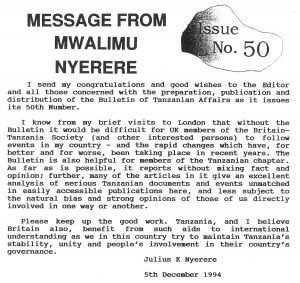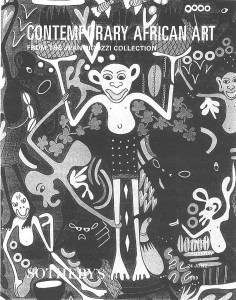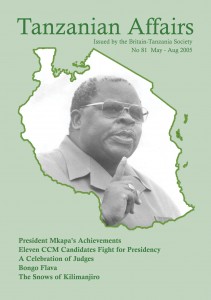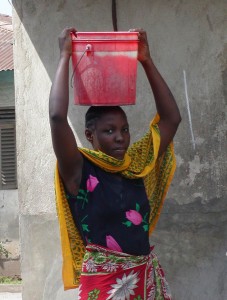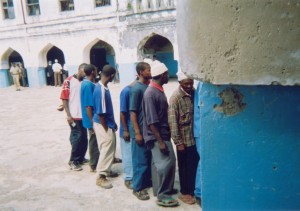Issue 50 (January 1995) contains a message from Julius Nyerere (reproduced above).
Issue 51 (1995) features an article by Christine Lawrence concerning the negative impact of the Canadian supported wheat scheme on the local Barabaig communities in Hanang district, and the projects that CIDA have started to try and redress the situation. The scheme was started with grand aims of improving Tanzania’s self reliance, (Issue 24), but little or no consideration given to the 40,000 Barabaig who depended on the land for a living. The project was ended in 1994 (“A Giant Mistake” – Issue 47), and Issue 57 contains a review of the excellent book “Pastures Lost” by Charles Lane on the project and its aftermath.
An interesting article by Alan and Heather Scott looks at the increasing numbers of human deaths between 1990 and 1994 as a result of crocodile attacks in Korogwe, many occurring when the town water pumps failed and people were forced to collect water from the Pangani River.
A detailed exploration of Taraab music in Zanzibar in Issue 52 concludes that the direction of the art form is being pushed by a network of women’s taraab clubs, moving in full circle back from the “swahilified” tarrab of Siti binti Saad back towards an “ideal” form of taraab as performed by Culture Music Club under Akhwani Safaa (Janet Topp Fargion). Lake Victoria is a “Sick Giant … murky, smelly and choking with algae…”, and the Nile Perch has come to dominate causing the extinction of 200 of the 400 species of fish that used to inhabit the Lake (People & the Planet).
Issue 53 covers the elections of October 1995 with Benjamin Mkapa elected president with 62% of the vote. The controversial election in Zanzibar is covered by editor David Brewin with the first of his “Election Diaries”. An arresting story “Popobawa is Dead” concerns the mob killing of a man suspected of being a “Popobawa” (a man with magical powers who rapes men and women in their homes). It was subsequently found that the man was a mental patient who had come to Zanzibar for treatment (Henriette Jansen).
Issue 54 notes the requirement for all Tanzanian nationals travelling to Britain (and vice versa) to obtain a visa. The TAZARA railway is operating at a loss, partly blamed on the successes of road hauliers, which is to be a recurring theme over the next decade.
A letter from John Cooper describes a pleasant and peaceful trip to Tanzania from their home in Rwanda, spoiled only by the noisy and extremely violent videos shown on the buses, and wonders if the British Council or other body might not be able to provide something more informative!
Issue 55 (Sept 1996) details Tanzania’s “Titanic” disaster when the MV Bukoba capsized on Lake Victoria on May 21st. In the sad days following the tragedy, some 392 bodies are recovered, but many more left in the wreckage which becomes a permanent tomb. An article on “Kilwa – from decay to development” describes the changes afoot to improve the dirty and derelict buildings in Kilwa Kivinje, including plans for a road from Dar-es-Salaam, private fishing industry growth and the development of the Songo Songa gas field. This is balanced by another article “The Demolition of Dar” lamenting the demolition of 176 plots to make way for 20 “ultra modern” structures with up to 26 storeys.
The deputy Prime Minister Michael Heseltine chooses Tanzania for his holidays, spending three weeks visiting game parks and Bagamoyo. Prince Charles and his sons William and Henry and Mrs Hilary Clinton and daughter Chelsea also visit in 1996/7.
Issue 56 contains a comparison of school days in Britain and Tanzania by Rob Grant. Jodie and Zawadi have very different experiences and the classroom atmosphere varies tremendously, but some things unite the two.
Issue 57 highlights the drought affecting four million people in nine regions of the country, and severe water shortages in Dar-es-Salaam. These are followed by severe floods in late March leading to the deaths of some 40 people in Kilwa district. The “Mpemba Effect” is a curious phenomenon whereby hot milk (or other liquids) will sometimes freeze more quickly then cold milk when placed in a freezer. Matthew Green tracks down Erasto Mpemba, finding him working for the Wildlife Department at the “Ivory Room” in Dar-es-Salaam. An Observer article “Barred from the Animal Kingdom” gives the views of three Maasai who have been on a speaking tour of the UK, complaining about the Tanzanian government driving them from their lands to create the Mkomazi Game Reserve in Same district. On the other hand the Trust which runs the Reserve claims an increase in elephant numbers from 2 to 1000 over a 25 year period, and that the area has recovered from the overgrazing and serious erosion that took place when the Masaai were there… This provokes angry letters in TA 58 vigorously defending the Game Reserve and pointing out the numerous errors in the Observer article.
Issue 58 (Sept 1997) covers the visit of Julius Nyerere to London, where he gave three speeches despite suffering from malaria, and received a lengthy standing ovation at the London School of Economics. Mwalimu celebrates his 75th birthday in Dar-es-Salaam, attended by over 1000 people. An article by Elias Songoyi describes the relationship between “Sukuma Singers and the State” and how singer Kalikali went too far in criticising the local party officials in 1965 and was detained in prison for two years, after which his songs were very different. Another artist, Mwinamila, was also critical of the state, but escaped imprisonment, the article suggests this was because his criticism was later (in the early 1980s) when perhaps the government was more confident, and also because he was a close associate of Nyerere.
An extract from VSO publication ORBIT in Issue 59 notes that Tanzania currently has only 3 telephone lines per 1000 people. Satellite phones are thought to be the solution to communication in remote areas. Anita Stomberg and Ben Rawlence write about the “Night Life in Dar-es-Salaam” varying from international discos such as “Club Billicanas” through to clubs playing Zairean Soukoss known as “Ndombolo”.
Issue 60 (May 1998) brings news of religious riots at Magomeni Mwembechai Mosque leading to the death of two people and 261 arrests. Simon Hardwick’s article “Kimbiji Revisited” recounts his return after 40 years to this village on the far side of the Kigomboni ferry – he finds the village much changed, but is still met with great hospitality. A dog in Sumbawamba is destroyed on the orders of a primary court magistrate after his owner gave him the name “Immigration” which the Magistrate deemed likely to cause a breach of the peace in the village. This causes outrage among animal lovers both in Tanzania and internationally (Majira).
“A day in the Life of Wadi Moja (Ward One)” by VSO volunteer Jean Cooper tells how an accident involving football supporters travelling in a lorry led to a sudden influx of 64 patients turning the ward into a battlefield. Notwithstanding the emergency, all patients are greeted by the nurses “Habari za afya” “Nzuri kidogo” (this from a man with blood pouring from his chin and leg in plaster from toe to groin!)
Issue 61 covers the horrific events surrounding the bombing at the American Embassy, killing ten people and injuring scores more. The Tanzanian High Commissioner in London Dr A Shareef congratulates Tanzania Standard Newspapers for entering the internet and the “fast lane world”, and invites visits to the High Commission’s own website. The issue also records the mass in St Alban’s Anglican Church attended by President Mkapa and Mwalimu Nyerere for the late Archbishop Trevor Huddleston KCMG. A service was also held in Westminster Abbey.
Issue 62 includes the first of Ben Rawlence’s articles “Kisa wa Kisasa” (also in Issues 63 and 64) where he gives some modern and colloquial Kiswahili, including a new meaning for “buzi” (goat).
Roger Carter comments in Issue 63 about the prospects for debt relief and criticism of the Heavily Indebted Poor Countries (HIPC) debt initiative.
Elspeth Court reports in Issue 64 on the sale of a painting by Georges Lilanga di Nyama at Sothebys for £8,200 more the three times the estimate.
Issue 65 (Jan 2000) is dominated by coverage of the funeral and memories of Mwalimu Nyerere (1922-1999). A meeting in London organised by the Jubilee 2000 campaign and attended by Prime Minister Frederick Sumaye condemns the World Banks HIPC initiative, and Dr Shareef compares it to a patient who is on his deathbed in a hospital, and instead of being given a blood transfusion is instead offered two aspirins a day to relieve the pain ! Issue 66 also features extracts from a paper by Ron Fennell on “Nyerere and the World Bank”.
As well as coverage of the build up to presidential elections, Issue 67 (Sept 2000) contains a sad extract from the Sunday Telegraph by Lindsay Hawdon describing a bus journey where an emaciated son boards with his mother and dies during the journey.
A large part of Issue 68 (Jan 2001) is taken up by David Brewin’s “Personal Election Diary” which gives readers a clear, believable and unbiased account of the “shambles” in Zanzibar.
An item from the New African in Issue 69 revealed the mobile phone revolution with Tanzania now having as many mobile phone lines as fixed lines. A letter from Tim Hardy described a memorable concert with the late Bibi Titi Mohammed in Mbeya in 1958 where as the solitary mzungu he was singled out for particular attention!
Issue 70 (Sept 2001) covers the increase in mining for gold and Tanzanite, and the first mention of the controversial Air Traffic Control system and the resulting dilemma for Prime Minister Tony Blair, as reported in the Financial Times.
Issue 71 brings news of another “agreement” in Zanzibar, but as is becoming something of a recurring theme, there are setbacks almost immediately. On a more positive note, the government abolishes school fees for primary schools as a result of a World Bank interest-free loan. There is an article about how Tanzanian dance bands such as Twanga Pepeta are managing to overcome the former domination of Zairean (Congolese) stars. Colin Hastings writes about a interesting safari while making a video about Tanzanian cultural tourism. The issue also included a review of “Bwana Shamba” by Peter Wilson recounting his experiences in Kilosa in the 1960s.
Issue 72 highlights disquiet over the Mkapa government’s privatisation policies, and the increasing stake held in particular by South Africans. However, economic indicators seem to show a positive story. Paul Harrison paints an evocative picture of Zanzibar at Idd el Fitr, though the Forodhani food market is closed due to a recent cholera outbreak.
Issue 73 contains information from Peg Snyder on the fifty Festival of the Dhow Countries which has ZIFF (Zanzibar International Film Festival) as its centrepiece. An interesting article by Alex Perulla describes an afternoon at FM Club in Kinondoni and the emerging Hip Hop music scene in Dar-es-Salaam. A train crash between Igandu and Msagali near Dodoma leaves 281 people dead and 371 injured.
“I had been happily married” begins an article from BBC’s Focus on Africa (in Issue 74), but a meeting with a traditional healer fails to provide the longed for children and instead prompts divorce. Mary Punt writes of the delights of travel with the “Scandanavian Express Bus Company” from Dar-es-Salaam to Iringa and the rest of the senior citizen’s safari.
Issue 75 highlights the differences in reporting of the Iraq War in Tanzania and the UK, and contains the census result that Tanzania’s population is 34 million, with 2.5 million of those living in Dar-es-Salaam.
Indigenisation (uzawa) is a hot topic in Issue 76 after MP Iddi Simba published a book suggesting that indigenous Tanzanians (as distinct from Asian Tanzanians etc) should be favoured under government economic policies. The calls are quickly rejected by the CCM party. The “50 years ago” section includes a report on the return of the Sultan of Zanzibar from the Queen’s Coronation in 1953, noting “… under his inspired leadership there is probably no more contended community than that to be found in Zanzibar”- the Editor has added a post-script that the Zanzibar Revolution took place three years later !
Issue 77 contains excited speculation that oil will soon be discovered, as prospecting continues off the coast and in the Rufiji Delta. Meanwhile, the World Food Programme starts emergency food aid for those in the centre and north of Tanzania worst affected by the long drought and floods. There is an interesting article by Martin Walsh and Helle Goldmann on their efforts to establish whether the Zanzibar Leopard (Pathera pardus adersi) is extinct. Another article confirms that a specimen of the ancient fish Coelocanth, suspected to have vanished 65 million years ago, has been caught in Kilwa.
The increasingly serious dispute over the use of water from Lake Victoria and the Nile Basin is covered in Issue 78 (May 2004).
Issue 79 marks a change in cover design to incorporate a photo, in this case of the ITV studios in Dar-es-Salaam to illustrate an article on the rise of television in Tanzania, with five channels now operating in Dar-es-Salaam and several nationwide.
Issue 80 concentrates on the newly privatised Dar-es-Salaam water supply service under criticism from ActionAid. The firm City Water, with the backing of UK firm BiWater, is said to be mismanaging the supply leading to the city being dry for several days on end. Eventually the government decides to terminate the contract (Issue 82) leading to a protracted court case that BiWater eventually loses (Issues 89,92). The issue also contains an obituary for Joan Wicken, the dedicated socialist and former Personal Assistant to the late Mwalimu Julius Nyerere, who made several contributions to TA over the years.
Issue 81 (May 2005) includes “A Celebration of Judges” by Jim Read describing the events to mark the Silver Jubilee of the Tanzanian Court of Appeal.
Ben Rawlence gives the background to the forthcoming elections in Zanzibar in Issue 82 and the unhappy history of former elections there.
Jakaya Kikwete’s great election triumph (winning 80% of votes) is covered in Issue 83. Less positive reading is David Brewin’s election diary from Zanzibar, with photographs of “Janjaweed” voters alleged to have been brought in from the mainland to support the CCM.
“The Walking Dream” in Issue 84 by Jane Bryce describes her return to Moshi and the house where she spent a happy childhood. Much has changed and is unfamiliar, but she is welcomed into her former house by Victor the new owner, and shares ugali and stew with him.
Issue 85 (and 86) cover the furore surrounding the film “Darwin’s Nightmare” about the infanticidal behaviour of the Nile Perch taken as a metaphor for human society, and implying that weapons are being smuggled into Tanzania in exchange for fish.
An article in Issue 86 “Tradition versus Modernity” covers the exchange visits between First Lady Salma Kikwete and the Swazi Queen Mother. There is criticism from Tanzanian feminist activists of Mrs Kikwete’s approval of the reed dance ritual, which provokes comparisons with the “Miss Tanzania” competitions which are gaining popularity in Tanzania. Karl Autun recounts the journey of an ngalawa (outrigger canoe) from Bagamoyo to the Norwegian Maritime Museum in Oslo.
Issue 87 covers the possible schism in the Anglican Church over the issues of homosexual priests, same-sex marriages and women bishops, and the views of Tanzanian bishops. President Kikwete visits the UK and speaks at a dinner hosted by the Britain-Tanzania Society, and receives a Newcastle United football shirt from Prime Minister Blair.
An article by Hildebrand Shayo highlights the issue of “BioPiracy” where Western companies take out copyrights on indigenous plants from developing countries and reap the profits from turning them into cosmetics, medicines etc.
As well as coverage of Business & the Economy by Joseph Sabas, Issue 88 includes a complaint on TA’s coverage of the meeting of the Anglican primates in Dar-es-Salaam, although the letter from Roger Bowen concludes “I remain a fan of your magazine and often recommend it”. Faye Cran describes how a Tanzanian with the unfortunate name of Hitler was ostracized from his community when he started losing fingers and toes, but eventually finds his way to the Upendo Leprosy Centre in Arusha where he now lives with 50 other leprosy sufferers and 31 children.
Issue 89 examines the allegations of corruption surrounding the BAE Radar, Bank of Tanzania Twin Towers, and Richmond Electricity Contract and other cases which are to rumble on for many more issues. Kasia Parham’s book “Dogodogo” is introduced, telling the stories of some Dar-es-Salaam street children at the Dogodogo centre which over the past fifteen years has helped some 1,500 children.
Issue 91 features an article on Uwanja wa Fisi (Hyena Square) an area of Dar-es-Salaam renowned for prostitution, which was visited by US star Kelly Rowland in support of the Staying Alive Foundation.
Peter Leonhardt describes a project to deliver internet connectivity to schools, hospitals and council offices in a remote part of the Serengeti via a single satellite link in Issue 92. The issue also contains a scholarly article on “Who conceived/led the way to Ujamaa?” by Lawrence Cockcroft, Gerald Belkin and Ralph Ibbott. John Sankey writes of an almost forgotten incident in Tanganyikan aviation history in 1920 involving a crash landing near Tabora during an attempt to fly from London to Cape Town (with something like 15 stops en route!). New co-editors Donovan McGrath and Jacob Knight are introduced.
John Meadley writes in Issue 93 about “The New ‘Choo Men’” who are servicing pit latrines in Dar-es-Salaam using small carts able to negotiate the small alleyways and provide a much more cost effective service than vacuum tankers.
“Kilimo Kwanza”, the governments new priority policy for agriculture is covered in Issue 94 (Sept 2009) , while Issue 97 covers the run up to the presidential election, and also features an article on the controversial “Serengeti Road” project.
Kikwete’s second term election success (61% of the vote) is covered in Issue 98 together with the formation of the Zanzibar government of national unity. Finally Issue 99 contains news of Pastor Masapila and the brew he is distributing in Loliondo which is claimed to be a “miracle cure”.

